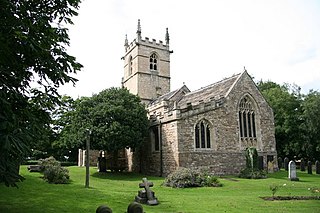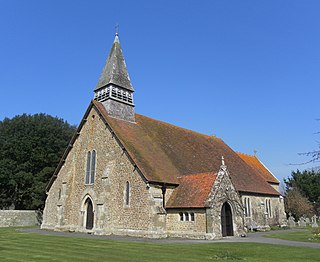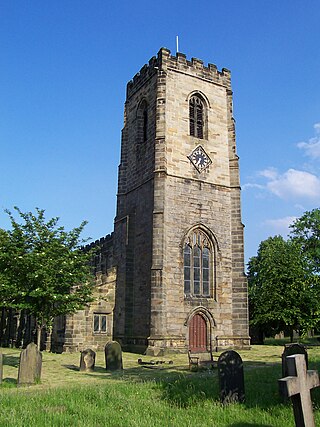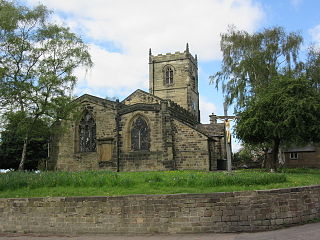
Halifax Minster is the minster church of Halifax, Calderdale, West Yorkshire, England. The church is dedicated to St John the Baptist. The parish church of the town, it was granted minster status in 2009. Halifax Minster is one of three churches in the county of West Yorkshire to be given this honorific title; the other two are Dewsbury Minster and Leeds Minster.

St John the Evangelist and St Mary Magdalene Church is a parish church in the Church of England Diocese of Sheffield in Goldthorpe, near Barnsley, South Yorkshire, England.
York had around 45 parish churches in 1300. Twenty survive, in whole or in part, a number surpassed in England only by Norwich, and 12 are used for worship. This article consists of a list of medieval churches which still exist in whole or in part, and a list of medieval churches which are known to have existed in the past but have been completely demolished.

St James' Church, High Melton is a parish church of the Church of England in High Melton, South Yorkshire, England.

St Mary's Priory Church, Deerhurst, is the Church of England parish church of Deerhurst, Gloucestershire, England. Much of the church is Anglo-Saxon. It was built in the 8th century, when Deerhurst was part of the Anglo-Saxon kingdom of Mercia. It is contemporary with the Carolingian Renaissance on mainland Europe, which may have influenced it.

St Wilfrid's Church stands to the north of the village of Mobberley, Cheshire, England. The church is recorded in the National Heritage List for England as a designated Grade I listed building. It is an active Anglican parish church in the diocese of Chester, the archdeaconry of Macclesfield and the deanery of Knutsford. Alec Clifton-Taylor includes it in his list of 'best' English parish churches.

Hickleton is a village and civil parish in the City of Doncaster in South Yorkshire, England. Historically part of the West Riding of Yorkshire, it had a population of 291, which had reduced slightly to 274 at the 2011 census. Hickleton is 6 miles (10 km) west of Doncaster and 8 miles (13 km) east of Barnsley.

The Church of St Mary, Ecclesfield, is situated on Church Street in the village of Ecclesfield, Sheffield, South Yorkshire, England. It is situated 4 miles (6.4 km) north of the city centre. It is a Grade I listed building, one of only five within the Sheffield city boundary. It was originally the parish church for Hallamshire, one of the largest parishes in England and in the seventeenth century was known as the "Minster of the Moors" due to its then rural situation.

Lancaster Priory, formally the Priory Church of St Mary, is the Church of England parish church of the city of Lancaster, Lancashire, England. It is located near Lancaster Castle and since 1953 has been designated a Grade I listed building. It is in the deanery of Lancaster, the archdeaconry of Lancaster and the Diocese of Blackburn. Its benefice is combined with that of St John and St Anne.

St Peter's Church is an Anglican church in the West Blatchington area of Hove, part of the English city of Brighton and Hove. Although it has 11th- and 12th-century origins, the church was rebuilt from a ruined state in the late 19th century and extended substantially in the 1960s, and little trace remains of the ancient building. The church serves the parish of West Blatchington, a residential area in the north of Hove near the border with Brighton.

St Peter's Church is the parish church of Selsey, West Sussex, and dates from the 13th century. The church building was originally situated at the location of St Wilfrid's first monastery and cathedral at Church Norton some 2 miles north of the present centre of population.

St Bees Priory is the parish church of St Bees, Cumbria, in England. There is evidence for a pre-Norman religious site, and on this a Benedictine priory was founded by the first Norman Lord of Egremont William Meschin, and was dedicated by Archbishop Thurstan of York, sometime between 1120 and 1135.

St Mary Magdalene is a parish church in the Church of England in Campsall in South Yorkshire. It is Grade I listed. There is a service every Sunday at 11:00.

St Mary the Virgin's Church is a former priory church in the village of Bromfield, Shropshire, England. It is an active Anglican parish church in the deanery of Ludlow, the archdeaconry of Ludlow, and the diocese of Hereford. Its benefice is united with those of 5 other parishes to form the Bromfield Benefice. The church is recorded in the National Heritage List for England as a designated Grade I listed building.
There are 62 Grade I listed buildings in South Yorkshire, England. In the United Kingdom, the term listed building refers to a building or other structure officially designated as being of special architectural, historical or cultural significance; Grade I structures are those considered to be "buildings of exceptional interest". In England, the authority for listing under the Planning Act 1990 rests with Historic England, a non-departmental public body sponsored by the Department for Culture, Media and Sport.

The Church of All Saints is the parish church in the village of Darton in South Yorkshire, England. It is a Church of England church in the Diocese of Leeds. The 16th-century building is Grade I listed and was built on the site of an earlier church. 1150 Is the earliest record of a church being on the site.

The Church of St Andrew the Apostle is the parish church in the village of Bolton upon Dearne in South Yorkshire, England. It is a Church of England church in the Diocese of Sheffield. The building is Grade I listed and features a Saxon nave incorporating arcade from the 12th century. Additions and alterations include the 14th century chancel and north aisle, a 15th/16th century tower and a 19th-century north chapel and vestry. The church contains memorial plaques for parishioners killed in the First and Second World Wars.

The Church of St John the Baptist is the parish church in the village of Royston in South Yorkshire, England. It is a Church of England church in the Diocese of Leeds. The building is Grade I listed and was built in the 12th century AD.

St Helen's Church is the parish church of Bilton-in-Ainsty, a village west of York in North Yorkshire, in England.

St Wilfrid's Church is the parish church of Brayton, North Yorkshire, immediately south-west of Selby in England.



















